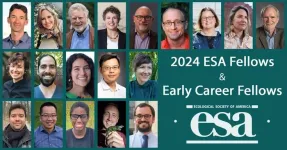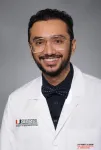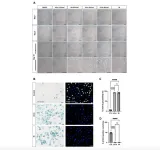(Press-News.org) Black drivers are more frequently searched during traffic stops without finding contraband than white drivers, according to a University of Michigan study.
Institute for Social Research scientists Maggie Meyer and Richard Gonzalez analyzed data from 98 million traffic stops, and showed that innocent Black drivers were likely to be searched about 3.4 to 4.5 percent of the time while innocent white drivers were likely to be searched about 1.9 to 2.7 percent of the time. Their results are published in the Journal of Quantitative Criminology.
"We show that there's this pervasive bias in multiple states and multiple counties across different stop and search reasons that we need to understand," said Meyer, a doctoral candidate in psychology. "We're not the first people to find racial bias in policing and we won't be the last, but hopefully, this gives a clear place to intervene."
Meyer and Gonzalez, director of the Research Center for Group Dynamics at ISR and professor of psychology, used data from the Stanford Open Policing Project, a database of traffic stops from law enforcement agencies across the country. They examined traffic stops in 14 state police departments and 11 local law enforcement departments between the years 1999 and 2017.
Meyer says that, for example, in Durham County, North Carolina, the false alarm rate for Black drivers ranges from 6 to 8% while the false alarm rate for white drivers is 3 to 4%. This equates to 11,000 Black drivers compared to about 2,500 white drivers who are searched while innocent.
"We know that there's at least this 2% difference at most, where the two values are the closest. That's where we can start to make these claims of bias," Meyer said. "The really powerful part about these data is that these findings aren't massive—they're not 30, 40%, they're 2, 3, 4, 5%. But at 98 million traffic stops across 14 states, that's still a very large and meaningful number of innocent drivers who are searched."
Officers' decisions result in tradeoffs between the probability of contraband in the population, the probability of finding contraband among those the officer selects to search, and the costs of making errors such as failing to search someone with contraband and needlessly searching someone without contraband, Gonzalez says.
The researchers had three pieces of information about these traffic stops: the total number of traffic stops during the time period in a given county or state, whether the officer searched their car, and whether they found contraband. They don't know whether drivers who weren't searched held contraband.
To account for this unknown, the researchers developed what they call the Overlapping Condition Test. They base this test on a standard descriptive tool in statistics called a 2x2 table. This table allows researchers to jointly evaluate a decision and an outcome. To do this, researchers use hit rates and false alarm rates.
In this context, hit rate is a measure of officer accuracy that depends on the contraband rate on any driver that was stopped, even if they were not searched. False alarm rates refer to the proportion of drivers officers search but do not find contraband, and it depends on the total number of innocent drivers that were stopped–even if they were not searched.
In this 2x2 table, the researchers filled in these known pieces of information: whether the officer searched and whether the officer found contraband when they searched. The researchers explored the possible values of the missing information—whether the drivers who were not searched had contraband or not.
"It's analogous to presidential elections with the electoral college. An election can be called because one candidate already has enough electoral votes to win, even though all of us haven't been counted," Gonzalez said. "So even though there may still be missing information, the outcome of the election is set. Even if those uncounted votes went for the other candidate, one candidate has already got it in the bag."
The researchers say their method can be used to inform policy to help mitigate the issue.
"We can move forward. We can say, 'Hey, there's a problem. We have to think about policy,''' Gonzalez said. "We have to figure out why officers are searching innocent Blacks more than innocent whites. We don't need to wait until we know the actual values of the missing information, because it doesn't matter what they are. The bias is there."
Study: Detecting bias in traffic searches: Examining false searches of innocent drivers
END
Study: racial bias is no 'false alarm' in policing
2024-04-30
ELSE PRESS RELEASES FROM THIS DATE:
Ecological Society of America announces 2024 Fellows
2024-04-30
The Ecological Society of America is pleased to announce its 2024 Fellows. The Society’s fellowship program recognizes the many ways in which its members contribute to ecological research, communication, education, management and policy. This year, the ESA Governing Board has confirmed nine new Fellows and ten new Early Career Fellows.
Fellows are members who have made outstanding contributions to a wide range of fields served by ESA, including, but not restricted to, those that advance or apply ecological knowledge in academics, ...
Mass General Brigham researchers identify potential drivers of chronic allergic inflammation
2024-04-30
Currently, most therapies for allergic diseases require lifelong treatment. Allergic reactions, characterized by ongoing (type 2) inflammation in response to chronic antigen exposure, underlie many chronic diseases in humans, including asthma, atopic dermatitis, ulcerative colitis and more. T helper 2 (Th2) cells play an important role in the body's immune response, particularly in allergic reactions. Despite their central role, the sustained activity of Th2 cells during allergic reactions, even in the face of constant antigen exposure, has long puzzled researchers.
A research team that included authors from Mass General Brigham, including ...
Scientists solve chemical mystery at the interface of biology and technology
2024-04-30
Link to release:
https://www.washington.edu/news/2024/04/30/oects/
Researchers who want to bridge the divide between biology and technology spend a lot of time thinking about translating between the two different “languages” of those realms.
“Our digital technology operates through a series of electronic on-off switches that control the flow of current and voltage,” said Rajiv Giridharagopal, a research scientist at the University of Washington. “But our bodies operate on chemistry. In our brains, neurons ...
Shaping the Future of Neuroendocrine Tumor Management
2024-04-30
MIAMI, FLORIDA (April 30, 2024) – Newly updated guidelines on neuroendocrine tumors developed by an expert at Sylvester Comprehensive Cancer Center at the University of Miami Miller School of Medicine and collaborators provide clinicians with the latest recommendations for staging and management of these rare but increasingly diagnosed tumors.
The guidelines, developed for the American Joint Committee on Cancer (AJCC) and summarized today in CA: A Cancer Journal for Clinicians, highlight recent changes for treating these tumors and offer a snapshot of this rapidly evolving ...
Scientists show ancient village adapted to drought, rising seas
2024-04-30
Around 6,200 BCE, the climate changed. Global temperatures dropped, sea levels rose and the southern Levant, including modern-day Israel, the Palestinian territories, Jordan, Lebanon, southern Syria and the Sinai desert, entered a period of drought.
Previously, archaeologists believed that this abrupt shift in global climate, called the 8.2ka event, may have led to the widespread abandonment of coastal settlements in the southern Levant. In a recent study published with the journal Antiquity, researchers at UC San Diego, the University of Haifa and Bar-Ilan University share new evidence suggesting at least one village formerly thought abandoned not only remained occupied, but ...
Cover paper: Senescent characteristics of human corneal endothelial cells upon UV-A exposure
2024-04-30
“[...] these findings may help to advance our understanding of the pathogenesis of corneal endothelial disease and may lead to the discovery of new therapies targeting senescent cells.”
BUFFALO, NY- April 30, 2024 – A new research paper was published on the cover of Aging (listed by MEDLINE/PubMed as "Aging (Albany NY)" and "Aging-US" by Web of Science) Volume 16, Issue 8, entitled, “Senescent characteristics of human corneal endothelial cells upon ultraviolet-A exposure.”
In ...
Activity in a room stirs up nanoparticles left over from consumer sprays
2024-04-30
Common household products containing nanoparticles – grains of engineered material so miniscule they are invisible to the eye – could be contributing to a new form of indoor air pollution, according to a Rutgers study.
In a study published in the journal Science of the Total Environment, a team of Rutgers researchers found people walking through a space, where a consumer product containing nanoparticles was recently sprayed, stirred residual specks off carpet fibers and floor surfaces, projecting them some three ...
NASA’s Webb maps weather on planet 280 light-years away
2024-04-30
An international team of researchers has successfully used NASA’s James Webb Space Telescope to map the weather on the hot gas-giant exoplanet WASP-43 b.
Precise brightness measurements over a broad spectrum of mid-infrared light, combined with 3D climate models and previous observations from other telescopes, suggest the presence of thick, high clouds covering the nightside, clear skies on the dayside, and equatorial winds upwards of 5,000 miles per hour mixing atmospheric gases around the planet.
The investigation is just the latest demonstration of the exoplanet science now possible with Webb’s ...
Webb captures top of iconic horsehead nebula in unprecedented detail
2024-04-30
NASA’s James Webb Space Telescope has captured the sharpest infrared images to date of a zoomed-in portion of one of the most distinctive objects in our skies, the Horsehead Nebula. These observations show the top of the “horse’s mane” or edge of this iconic nebula in a whole new light, capturing the region’s complexity with unprecedented spatial resolution.
Webb’s new images show part of the sky in the constellation Orion (The Hunter), in the western side of a dense region known as the Orion B molecular cloud. Rising from turbulent waves of dust and gas is the Horsehead Nebula, otherwise known as ...
Researchers reveal a new approach for treating degenerative diseases
2024-04-30
Proteins are the workhorses of life. Organisms use them as building blocks, receptors, processors, couriers and catalysts. A protein’s structure is critical to its function. Malformed proteins not only fail to carry out their tasks, they can accumulate and eventually gum up the inner workings of cells. As a result, misfolded proteins cause a variety of degenerative diseases, from Alzheimer’s and Parkinson’s to the blinding disease retinitis pigmentosa. These disorders are currently incurable.
A paper out of UC Santa Barbara reveals a new connection between ...






